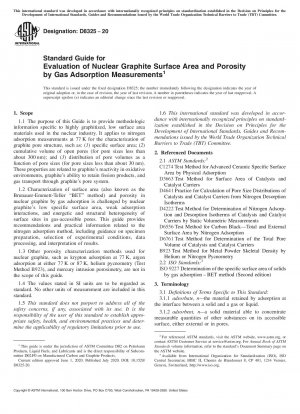ASTM D8325-20
Standard Guide for Evaluation of Nuclear Graphite Surface Area and Porosity by Gas Adsorption Measurements
- Standard No.
- ASTM D8325-20
- Release Date
- 2020
- Published By
- American Society for Testing and Materials (ASTM)
- Latest
- ASTM D8325-20
- Scope
- 1.1 The purpose of this Guide is to provide methodologic information specific to highly graphitized, low surface area materials used in the nuclear industry. It applies to nitrogen adsorption measurements at 77 K for the characterization of graphite pore structure, such as: (1) specific surface area; (2) cumulative volume of open pores (for pore sizes less than about 300 nm); and (3) distribution of pore volumes as a function of pore sizes (for pore sizes less than about 30 nm). These properties are related to graphite’s reactivity in oxidative environments, graphite’s ability to retain fission products, and gas transport through graphite’s pore system. 1.2 Characterization of surface area (also known as the Brunauer-Emmett-Teller “BET” method) and porosity in nuclear graphite by gas adsorption is challenged by nuclear graphite’s low specific surface area, weak adsorption interactions, and energetic and structural heterogeneity of surface sites in gas-accessible pores. This guide provides recommendations and practical information related to the nitrogen adsorption method, including guidance on specimen preparation, selection of experimental conditions, data processing, and interpretation of results. 1.3 Other porosity characterization methods used for nuclear graphite, such as krypton adsorption at 77 K, argon adsorption at either 77 K or 87 K, helium pycnometry (Test Method B923), and mercury intrusion porosimetry, are not in the scope of this guide. 1.4 The values stated in SI units are to be regarded as standard. No other units of measurement are included in this standard. 1.5 This standard does not purport to address all of the safety concerns, if any, associated with its use. It is the responsibility of the user of this standard to establish appropriate safety, health, and environmental practices and determine the applicability of regulatory limitations prior to use. 1.6 This international standard was developed in accordance with internationally recognized principles on standardization established in the Decision on Principles for the Development of International Standards, Guides and Recommendations issued by the World Trade Organization Technical Barriers to Trade (TBT) Committee.
ASTM D8325-20 Referenced Document
- ASTM B923 Standard Test Method for Metal Powder Skeletal Density by Helium or Nitrogen Pycnometry*, 2023-11-15 Update
- ASTM C1274 Standard Test Method for Advanced Ceramic Specific Surface Area by Physical Adsorption
- ASTM D3663 Standard Test Method for Surface Area of Catalysts and Catalyst Carriers
- ASTM D4222 Standard Test Method for Determination of Nitrogen Adsorption and Desorption Isotherms of Catalysts By Static Volumetric Measurements
- ASTM D4641 Standard Practice for Calculation of Pore Size Distributions of Catalysts from Nitrogen Desorption Isotherms
- ASTM D6556 Standard Test Method for Carbon Black—Total and External Surface Area by Nitrogen Adsorption*, 2021-05-01 Update
- ASTM D6761 Standard Test Method for Determination of the Total Pore Volume of Catalysts and Catalyst Carriers*, 2022-08-01 Update
- ISO 9227 Corrosion tests in artificial atmospheres — Salt spray tests — Amendment 1: Footnote of Warning*, 2024-02-19 Update
ASTM D8325-20 history
- 2020 ASTM D8325-20 Standard Guide for Evaluation of Nuclear Graphite Surface Area and Porosity by Gas Adsorption Measurements
